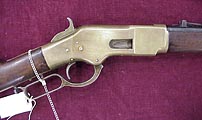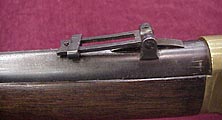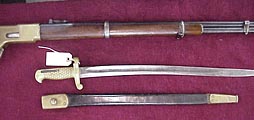
|
|
Russo-Turkish War of Liberation 1877-1878 Chapter Three - Small arms of the warring states - Ottoman empire "Winchester" model 1866 The rifle and carbine Winchester model 1866 were among the firearms of the Ottoman army. The weapon was named after the owner of the arms company “Winchester Arms Company”, Oliver Fisher Winchester. The company produced these rifles and carbines from 1866 to 1891. The name “Henry-Winchester” is also used as a sign of respect for one of its constructors – Benjamin Taylor Henry. The arms system “Winchester” has not been created by a single person; it rather represents a series of improvements by different people. The beginning was set by the rifle of Walter Hunt in 1874. In its outer appearance, it is different from Winchester but it has a sub-barrel tube chamber and a leverage system for cartridges. It is followed by the improved rifles of Jennings and Smith-Jennings and the cartridge pistol and rifle of Smith and Wesson, whose construction follows the same principle. In 1855, the company Volcanic Arms Company was established, whose vice-chairman was Winchester, and chief manager – Daniel Wesson. They manufactured mainly rifles and carbines Volcanic. In 1857, the company was re-organized as New Haven Arms Company after the name of the town, where it was located. By 1860, the company manufactured also carbines Volcanic model 1854. Drawing on the principles used in the construction of Volcanic, the arms constructor Benjamin Taylor Henry created a system known as Henry model 1860. It was manufactured until 1866 at the total amount of 13,000 pieces1 using Henry cartridges with rim fuse and caliber of 11 mm. In 1866, another prominent arms specialist Nelson King working at Winchester introduced some changes and additions to the Henry system. The most important is the cartridge door on the right side of the breech bolt case, the which the magazine is loaded. By that time the loading was done through the front opening of magazine. In the course of time the new system had been established with its name, and its barrel carried the names of the two constructors, Henry and King, as well as their patent dates. The Winchester was produced in four models with insignificant technological differences between them. The system was developed for three versions of fires arms – for the infantry, an octahedral-barrel rifle for hunting, and a carbine. The first model carbines had numbers from 12,476 to 15,000, including 1,000 rifles with an octahedral barrel.2 The second version had numbers from 25,000 to 100,000. The fourth version is numbered from 100,000 to 170,000.3 The first model was produced around 1866-1867 and the second model – around 1867-1870. The period of 1870-187, when carbines and rifles of the third version were produced, can be considered the most important one for the scope of this study. During this period, the Ottoman Empire made two orders: • on 9 November 1870 – 15,000 rifles and 5,000 carbines4 • on 19 November 1871 – 30,000 rifles5 In 1877 H. Zboinski, Professor from the Constantinople Military School, published his book The Ottoman Empire , describing in detail the available fire arms. It is not known why he has mentioned the existence of double quantities of Winchester in a reverse ratio between rifles and carbines. On this matter, it is necessary to take into account Reuters reports of 11 August 1877, according to which the John Bramal ship left the New Haven port loaded with arms and ammunitions at the value of 1,200,000 dollars. In the Ottoman army the cavalry the irregular Cherkessk units used by the police were armed with Winchester. Two out of four cavalry regiments included in the staff of every the army corps were armed with Winchester rifles with 16 cartridges. The first and sixth squadrons of the third and fourth regiments had carbines with 12 cartridges. For a speedy fire, the cavalry and the Cherkessk units carried weapons on their right shoulders attached to a strap with a metal ring. They fired without taking off the strap. The participation of Winchester in the war was not quite successful. Due to the comparatively unstable cartridge, it could not be used in serious firing between army units. It had shown good efficiency in the hands of irregulars. Winchester rifles were most probably used for keeping a thick fire in close-distance combats. According to some authors, the rifle magazine could fire for 15 seconds. It can be seen in some original photos of Russian officers and soldiers that they carry rifles Winchester. This weapon was not part of the Russian armament, but some trophy samples light have been used. Russian had taken back to Russia some of the seized Winchester rifles as a valuable military trophy. The Winchester model 1866 was known in Bulgaria before the Liberation. The missionaries of the fourth revolutionary district during the April Uprising were armed with Winchester. After to the war, in 1881 the Ottoman Empire had around 20,000 Winchesters. The rest were rendered inefficient or were seized by Russian and Bulgarians.
|
Mannlicher ©2003-2004. All rights reserved. No part of this site can be reproduced in any way without the explicit permission of the authors.




